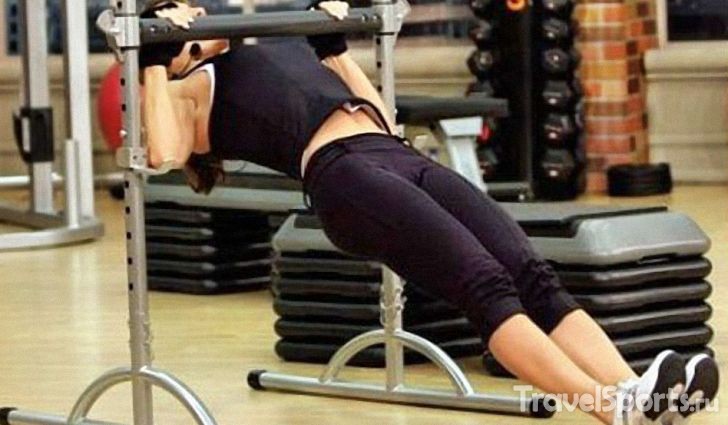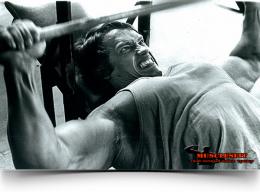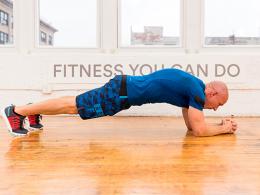How to learn to pull up on the horizontal bar
In order to form the relief muscles of the upper and middle parts of the body in a short time without the help of special devices or visiting the gym, it is enough to learn how to pull yourself up on the horizontal bar at home. A simple exercise activates the muscles of the arms, shoulders, back and helps to increase muscle tone and improve physical fitness.
How to properly pull up on the horizontal bar
The pull-up cycle is conditionally divided into the following phases:
- starting position - hanging on the horizontal bar;
- climb;
- hanging on bent arms;
- return to starting position.
In the initial position, the body is straightened, the heels are together, the hands are shoulder width apart, the fingers cover the crossbar. The load is experienced by the shoulder girdle and upper limbs. In this phase, the muscles regain strength after the next pull-up.
When lifting, the shoulders work. The load on the biceps, the broadest is determined by the width of the grip. As a rule, the torso is raised while inhaling or, much less often, while holding the breath.
Hanging on bent arms is practically absent. As a rule, this is the phase when the chin is above the level of the bar. A delay in this phase is a sign of irrational exercise, since most of the muscles are extremely tense.
The return to the starting position is performed by the same muscles, but already compensating for the effect of gravity. Lowering too sharply gives the muscles more rest, but is fraught with the risk of falling off the bar on the final return to the starting position.
The best grip is shoulder width. But depending on the degree of training of individual muscle groups, you can choose a wider or narrower grip - the one that is more convenient. It is the comfortable position of the hands that will allow the beginner to learn how to pull himself up the maximum number of times.
When doing pull-ups, the depth of the grip matters. The grip is deep, when the brush tightly wraps around the bar at a certain angle, shifting the center of gravity from the fingers to the middle of the palm and thus slightly reducing the distance from the chin to the bar. This grip reduces the effort when doing pull-ups.
When the grip weakens, the body is held by the muscles of the fingers. The finger grip lengthens the path to the crossbar, making it difficult for the shoulder and spinal muscles to work.
To learn how to pull up on the horizontal bar from scratch, it is necessary to form the correct technique from the first lessons:
- Hang on the bar, palms away from you (straight grip), arms straight, hands slightly wider than shoulders to be comfortable, legs hang freely, do not touch the floor, heels together, body does not sway.
- Bring the shoulder blades together, while exhaling, gently pull the chin above the crossbar, elbows pointing down. During the rise, the shoulders are laid back, the chest is protruded forward.
- Hold the position for a fraction of a second.
- Inhale and slowly lower your body to the starting position.
All movements should be strong and smooth, without jerks, especially before moving up. It is necessary to pull yourself up while you manage to observe the correct technique of sports movements.
How to learn to pull up for a beginner from scratch

If you can’t pull yourself up on the horizontal bar even once, in addition to strengthening the muscles with the help of various exercises or exercises on simulators, you should first perform various types of clothed pull-ups.
Pull-ups on a low horizontal bar. Securely fasten the crossbar at a distance of 70-90cm from the floor. Hang on it, heels rest on the floor. It is better to use a direct grip (palms away from you). But if pulling up is difficult, you can train with a reverse grip. With the growth of sports training, gradually change the height of the crossbar so that the muscles receive a greater load.
Pull-ups with an expander. To facilitate pull-ups, attach a long expander to the crossbar so that it forms a large loop. Hang on the horizontal bar, place the feet in the loop formed by the expander. When the body moves up, the expander will create a force that facilitates the rise.
Support use. Adjust the height of the horizontal bar so that in the initial position, rest on the floor with your toes or place a reliable support under the crossbar. When moving the body up, the efforts of the toes will facilitate the work of the muscles of the upper body.
Negative pull-ups. For those who do pull-ups from scratch, to strengthen and develop muscle strength, it is useful to work out the last phase of the sports movement - returning to the starting position (down). Using a chair or just jumping up, hang on the horizontal bar with bent arms, chin over the crossbar. Slowly lower your torso until your arms are fully extended.
Holding the hang with bent arms. This exercise helps you learn how to pull up by training your muscles to support your body weight when your chin is over the bar. After a few seconds of hanging, slowly lower the body down so that the feet are on the floor or support. The shoulder blades are brought together.
Those who want to learn how to pull themselves up on the horizontal bar from scratch should not force things and strive at any cost to increase the number of repetitions, since this is self-deception. Twenty jerky movements without technique will bring much less benefit than 6-8 correctly performed pull-ups.
How to learn to pull up 30 times

Once your body is strong enough to be able to perform one or more "real" pull-ups, it's time to work on improving your results.
It is better to do it every other day, three times a week (Monday-Wednesday-Friday). During the day of rest, the body will restore strength and will be able to withstand the next workout with higher loads.
Rest between sets is at least a minute.
First week
A beginner who is just mastering pull-ups from scratch will have to dose the load in the first week.
- First day. Three approaches one time.
- Second day. Four approaches one time.
- Third day. Four approaches one time, the fifth - one time or more.
Second week
- First, second, third days. Four approaches one time, the fifth - one time or more.
At the end of the second week, a day after the third day of classes, pull yourself up as much as possible, remember the result.
Third week
If you managed to pull yourself up three or more times in the test of the second week, you can proceed to the exercises of the third week. If the result is less than three, you will have to re-learn how to pull yourself up on the horizontal bar according to the program of the second week.
- First day. Two sets of 2 pull-ups, then two sets of 1 rep. Fifth - two or more.
- Third day. Four sets of two pull-ups, the fifth - two or more.
Fourth week
- First day. Four sets of two pull-ups, the fifth - three or more.
- Second day. Four sets of two pull-ups, the fifth - three or more.
- Third day. Two sets of three pull-ups, then two sets of two. Fifth - five or more.
At the end of the week, a day after the third day of classes, pull yourself up as much as possible, remember the result.
Fifth week
If you managed to pull yourself up more than six times in the test of the third week, you can proceed to the exercises of the fifth week. Otherwise, learn to pull up on the horizontal bar again according to the program of the third or fourth week.
- First day. Four sets of 3 pull-ups, fifth set of three or more.
- Second day. Seven sets of two pull-ups, the eighth - four or more.
- Third day. Seven sets of two pull-ups, the eighth - five or more.
At the end of the week, a day after the third day of classes, pull up as much as possible.
sixth week
If the test failed to pull up more than 9 times, you will have to repeat the fifth week.
- First day. The first approach is four pull-ups, the second is five, the third is four, the fourth is three, the fifth is seven or more.
- Second day. The first and second approach - two pull-ups, the third and fourth - three, fifth, sixth, seventh, eighth - two, ninth - eight or more.
- Third day. The first and second approach - two pull-ups, the third, fourth, fifth, sixth, seventh - three, eighth - nine or more.
If the sixth week seemed difficult, it can be repeated.
After two days of rest, pull up as much as you can. If the result is not satisfactory, it is worth re-passing the last two weeks.
Modified: 08/11/2018





